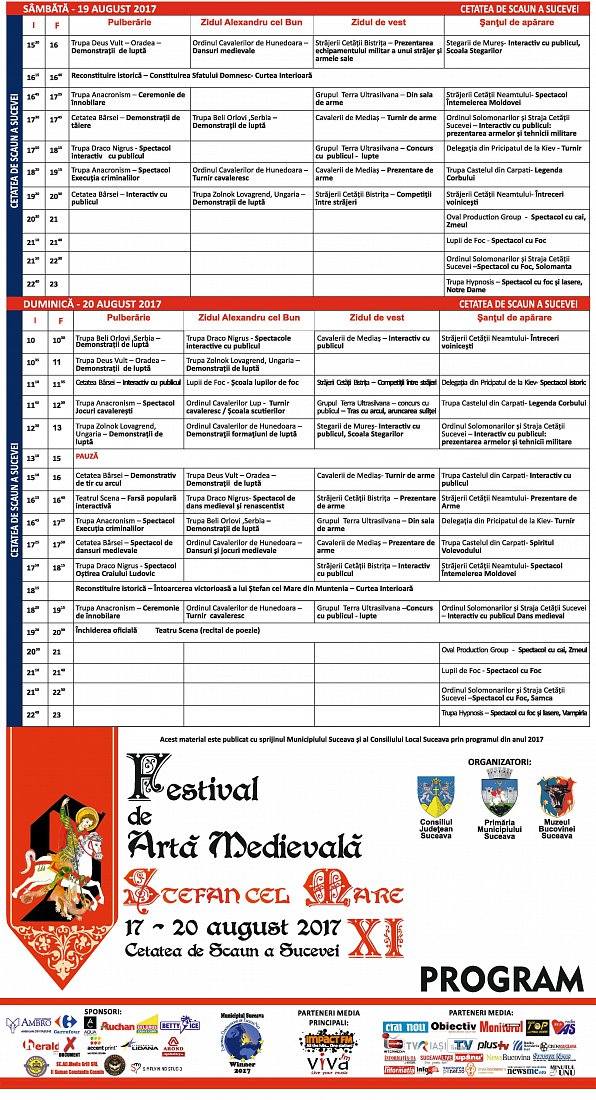Program Savcom Suceava
Suceava Fortress. Points of Interest:The Throne Fortress. Situated on a high plateau in the Eastern side of the city and restored in the last years, the fortress is a foundation belonging to the voivod Petru I Musat. It was mentioned in documents for the first time in 1388 and it was built of stone in the beginning, but afterwards the fortress was surrounded by lofty walls( over 10 m tall and almost 4 m thick), which make it impugnable.The Ruins of the Royal Court. Over the ruins of a wooden palace dating Petru I Musat’s reign, voivod Stefan the Great’s founded a stone edifice. It was rebuilt later by Vasile Lupu. Today, one may see there traces of some chambers and cellars.The Equestrian Statue of Stephen the Great.
Tee work of Eftimie Barleanu sculptor, revealed in 1977, on the height where the Suceava Fortress dominated the town. The Science of Nature’s Department.The Science of Nature’s Department, shows paleontology collections, the flora and the fauna from that region. In the same building, the Plastic Arts Section is opened.Popular Art Museum. Opened in the former Royal Inn, built sometime in the end of the 15th century. Nowadays it has been restored and holds collections of ethnography and popular art.Mirauti monument of medieval architecture. This is one of Petru I Musat’s foundations(14 th century), rebuilt completely in the 17th century. In this edifice, the rulers of Moldavia used to be crowned.Scheia Fortress.
Situated at 384 m altitude, in the North-Western side of the city, the fortress was build in the 14th century, having the shape of a rhombus.The medieval architecture monument. Being Petru Rares’ foundation, it holds in its yard a tower that is 30m tall, tower that was built by Alexandru Lapusneanu in 1561. The symbol of old Moldavia is carved on one of its walls. The District Museum – Suceava.The District Museum. Established in 1900, it presents interesting items which conjure up the past rich in events and the heroic deeds of the inhabitants of these lands. Greater importance may be given to the throne hall, which actually reconstitutes the same environments that used to be at Stefan the Great’s royal court (costumes, furniture and so on). The Natural Sciences Section exhibits paleontology collections, the flora and fauna from the area.
Program Savcom Suceava 2017
In the same building, one may find the Plastic Art Section.Petru I Musat’s statue. It is Paul Vasilescu’s work and it lies in front of the House of Culture.The Central Park. It is situated in the “heart of the city” and holds two masterpieces: Ciprian Porumbescu’s bust(made by sculptor Ioan Cirdei in 1933) and Petru Rares’ bust (realized by Gavril Covalschi in 1977).“Ciprian Porumbescu” Complex of Museums. It lies 25 km away from the city following the road DN17 in “ Ciprian Porumbescu “ village. The museum can be found in the building of an old lordly house and in the “Ciprian Porumbescu” Memorial House.it was founded by Stefan the Great and lies 1, 5 km away from the centre of Suceava city.it lies in the centre of Suceava city and it is now the residence of the archibishop of Suceava and Radauti.Stefan the Great’s foundation(1487), it lies 8 km away from Suceava city.it lies in the locality named Mitocu Dragomirnei, 10 km away from Suceava city.
(1930). Total121,327. Acrobat 8.1 update 2017 - reviews 2017. Density93/km 2 (240/sq mi). Summer In the, between the early 20th century up to the end of the 1940s, the county had a smaller size and population. The contemporary Suceava county is the result of the merger of other smaller former Romanian counties from the historical province of Bukovina that were functional mostly throughout the interwar period (e.g. Or ).The present-day Suceava County also incorporates part of. As per the administrative reform of 1938 under, the whole counties which divided Bukovina in the Kingdom of Romania were united into a bigger land called.As for the historical interwar Suceava County, this administrative unit was located in the northern part of and in the southern part of the historical region of respectively.
Its territory is situated entirely within the borders of the current Suceava County, constituting thus the central-eastern part of the contemporary namesake county. During the interwar period, it was the smallest county of Greater Romania by area, covering 1,309 square kilometres (505 sq mi).It is bordered on the east by the counties of and, to the north by, to the west by, and to the south by.Administrative organization. Communes.
Program Savcom Suceava Live
Villages.2010 floods During June 2010, the president of Suceava County, told the news agency that his region was one of the worst hit in the country. In the morning of June 29, relief work was coordinated to deal with flooding that killed 21 people, and caused hundreds to be evacuated from their homes. Gallery. Romanian-French playwright. Ukrainian-German writer.
Ukrainian-German writer and educator. German writer. Lipovan poet. Romanian poet and writer. Romanian poet. Romanian actor. Romanian folklorist.

Bauturi

Romanian 16th century Roman Catholic monk. German Roman Catholic archbishop.

marine geologist. Romanian Olympic rower. Romanian-German footballer. German linguist, journalist, and politician. German abstract painter. German politician in the.
Russian-Danish painterReferences Wikimedia Commons has media related to.